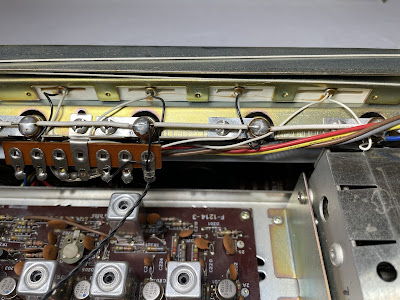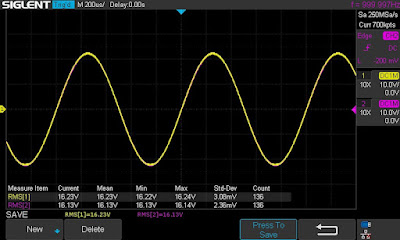Unit: Stereo Integrated Amplifier
Manufacturer: Marantz
Model: 1060
SN: 13050
Today, I'm showcasing one of the most well-known, respected, and popular integrated amplifiers of the 70's. This amplifier is one of the most valuable among collectors, and its price only gets higher over time. As many of you might guess, this is a Marantz Model 1060.
Marantz 1060 was manufactured from 1971 to 1978. It produces 30 watts per channel into 8 ohms with no more than 0.5% total harmonic distortion. The optional walnut veneer cabinet for this model is WC-10.
Power Supply Board (P800)
The power supply unit provides +35V DC (pin J806) to the phono amplifier and +27V DC (pin J807) to the tone & pre-amplifier board.
Four electrolytic capacitors (C803, C804, C805, and C806) installed on this board were replaced with low-impedance, high-reliability Nichicon UPW/UPM e-caps. The dried glue under each capacitor was carefully removed. The original e-caps were tested using an Atlas ESR70 capacitance meter. The capacitance of two out of the four capacitors was found to be outside the factory tolerance of ±20%.
Test results on original capacitors removed from the power supply board:
C803: rated capacitance – 470uF, measured – 549uF, ESR – 0.01Ω, deviation: +17%
C804: rated capacitance – 100uF, measured – 161uF, ESR – 0.06Ω, deviation: +61%
C805: rated capacitance – 330uF, measured – 353uF, ESR – 0.02Ω, deviation: +7%
C806: rated capacitance – 100uF, measured – 154uF, ESR – 0.03Ω, deviation: +54%
The original semiconductor devices on this board were also replaced to improve the reliability of the power supply. The regulating transistor 2SC1318, located at position H801, was replaced with a new Fairchild KSC2383YTA. The two SIB-01-02 diodes at positions H802 and H803 were upgraded to fast recovery rectifiers (UF4005).
Power supply board - before and after
Tone & Pre-Amplifier Board (P400)
The tone and pre-amplifier board contains eight low-leakage capacitors (C403, C404, C407, C408, C410, C411, C412, C413), two bipolar electrolytic capacitors (C414, C415), and three aluminum electrolytic capacitors (C405, C406, C409). The original low-leakage capacitors (except for C407 and C408) and both bipolar capacitors were replaced with high-quality WIMA polyester film capacitors. Capacitors C407 and C408 were replaced with low-leakage Nichicon UKL caps. The remaining aluminum electrolytic capacitors were replaced with low-impedance Nichicon UPW/UPM caps.
Test results on original capacitors removed from the tone & pre-amplifier board:
C403: rated capacitance – 1uF, measured – 1uF, ESR – 4.4Ω, deviation: 0%
C404: rated capacitance – 1uF, measured – 1uF, ESR – 4.2Ω, deviation: 0%
C405: rated capacitance – 10uF, measured – 10uF, ESR – 1.56Ω, deviation: 0%
C406: rated capacitance – 10uF, measured – 10uF, ESR – 1.63Ω, deviation: 0%
C407: rated capacitance – 3.3uF, measured – 3.5uF, ESR – 1.87, deviation: +6%
C408: rated capacitance – 3.3uF, measured – 3.4uF, ESR – 2.1Ω, deviation: +3%
C409: rated capacitance – 100uF, measured – 104uF, ESR – 0.09Ω, deviation: +4%
C410: rated capacitance – 3.3uF, measured – 3.5uF, ESR – 2.1Ω, deviation: +6%
C411: rated capacitance – 3.3uF, measured – 3.4uF, ESR – 2.6Ω, deviation: +3%
C412: rated capacitance – 0.47uF, measured – 0.48uF, ESR – N/A, deviation: +2%
C413: rated capacitance – 0.47uF, measured – 0.48uF, ESR – N/A, deviation: +2%
C414: rated capacitance – 1uF, measured – 1uF, ESR – 2.6Ω, deviation: 0%
C415: rated capacitance – 1uF, measured – 1uF, ESR – 2.8Ω, deviation: 0%
All original Toshiba 2SC1000 transistors installed on this board were replaced with modern low-noise Fairchild KSC1845s. The replacement transistors share the same pinout as the originals, ensuring a straightforward drop-in replacement.
According to the service manual, the PNP transistors in this circuit should be 2SA493. However, this board was populated with 2SA702 transistors instead. Although the failure modes of the 2SA702 are not well documented, they are known to be less reliable and have also been replaced. New Fairchild KSA992 transistors were installed in place of the 2SA702s to improve long-term reliability.
Tone & pre-amp board - before and after
Phono Amplifier Board (P900)
The phono amplifier board contains four low-leakage capacitors (C901, C902, C905, C906) and three aluminum electrolytic capacitors (C909, C910, C919). The original low-leakage capacitors at positions C901 and C902 were replaced with high-quality WIMA polyester film capacitors. The remaining two low-leakage capacitors (C905 and C906) were replaced with modern low-leakage Nichicon UKL types. The aluminum electrolytic capacitors were upgraded to low-impedance Nichicon UPW/UPM series.
Test results on original capacitors removed from the phono amplifier board:
C901: rated capacitance – 1uF, measured – 0.9uF, ESR – 4.2Ω, deviation: -10%
C902: rated capacitance – 1uF, measured – 1uF, ESR – 3.8Ω, deviation: 0%
C905: rated capacitance – 22uF, measured – 23uF, ESR – 0.31Ω, deviation: +5%
C906: rated capacitance – 22uF, measured – 23uF, ESR – 0.68Ω, deviation: +5%
C909: rated capacitance – 47uF, measured – 66uF, ESR – 0.32Ω, deviation: +40%
C910: rated capacitance – 47uF, measured – 57uF, ESR – 0.35Ω, deviation: +21%
C919: rated capacitance – 100uF, measured – 138uF, ESR – 0.12Ω, deviation: +38%
This board also contains two types of notoriously unreliable transistors: 2SC1000 and 2SC458. Both are known to become noisy over time and are common sources of audio issues. I replaced all of them with modern low-noise Fairchild KSC1845 transistors. Transistors H905 and H906 were gain-matched within 1% for optimal performance.
Pay close attention to pinout orientation when installing replacements. The original 2SC1000 shares the same ECB pinout as the KSC1845. However, the 2SC458 has a BCE pinout.
Phono amplifier board - before and after
Power Amplifier Board (P700)
The power amplifier board in this unit had been previously serviced, but unfortunately, the work was done poorly. Low-quality electrolytic capacitors were installed in several positions, and the overall soldering quality is very unreliable. In one case, a resistor lead was bent through the PCB hole but left unsoldered, posing a risk of intermittent connection or failure. Due to these issues, all previous work needed to be redone to ensure proper function and long-term reliability.
Bad soldering, one lead was bent but not soldered to the PCB
The power amplifier board contains four low-leakage electrolytic capacitors (C701, C702, C711, C712) installed in the signal path, along with eight aluminum electrolytic capacitors (C703, C704, C707, C708, C709, C710, C717, C718). The original low-leakage capacitors at positions C701 and C702 were replaced with WIMA polyester film capacitors. The remaining low-leakage capacitors (C711 and C712) were replaced with modern low-leakage Nichicon UKL caps. All remaining aluminum electrolytic capacitors were upgraded to low-impedance Nichicon UPW/UPM series.
I tested all the electrolytic capacitors removed from this board using an Atlas ESR70 capacitance meter, and the results are as follows: the measured capacitance of C709 was only 13µF, representing a 72% deviation from the rated value. Additionally, capacitor C718 failed the test entirely, exhibiting either an open circuit or very low capacitance.
Test results on original capacitors removed from the power amplifier board:
C701: rated capacitance – 1uF, measured – 1uF, ESR – 4.1Ω, deviation: 0%
C702: rated capacitance – 1uF, measured – 0.9uF, ESR – 4.3Ω, deviation: -10%
C703: rated capacitance – 47uF, measured – 45uF, ESR – 0.52Ω, deviation: -4%
C704: rated capacitance – 47uF, measured – 55uF, ESR – 0.1Ω, deviation: +17%
C707: rated capacitance – 47uF, measured – 48uF, ESR – 0.32Ω, deviation: +2%
C708: rated capacitance – 47uF, measured – 57uF, ESR – 0.28Ω, deviation: +21%
C709: rated capacitance – 47uF, measured – 13uF, ESR – 0.85Ω, deviation: -72%
C710: rated capacitance – 47uF, measured – 46uF, ESR – 0.26Ω, deviation: -2%
C711: rated capacitance – 10uF, measured – 11uF, ESR – 1.43Ω, deviation: +10%
C712: rated capacitance – 10uF, measured – 11uF, ESR – 1.16Ω, deviation: +10%
C717: rated capacitance – 22uF, measured – 22uF, ESR – 2.5Ω, deviation: 0%
C718: rated capacitance – 22uF, measured – open circuit/low capacitance
Both original pre-driver transistors (H701 & H702) were upgraded to the new Fairchild KSC945CYTA.
The original trimming resistors R723/R724 (100 kΩ, clipping level) and R729/R730 (470 Ω, Bias) were replaced with new Bourns potentiometers.
Power amplifier board - before and after
Power Transistors
Two power transistors in the left channel of this unit had been previously replaced with Sylvania ECG280 transistors, while the two transistors in the right channel are original Marantz 2SC897D. I tested all power transistors using an Atlas DCA55 semiconductor analyzer, and all of them are still functioning properly. However, I am unfamiliar with the performance and quality of Sylvania power transistors, which raised concerns regarding their long-term reliability. As a precaution, I decided to replace all four power transistors with new ON Semiconductor MJ21194G transistors.
These new transistors are specifically designed for high-power audio output and offer excellent gain linearity. According to the datasheet, the total harmonic distortion (THD) for two matched pairs of MJ21194G transistors can be as low as 0.08%, making them an ideal replacement for the original 2SC897D. To ensure optimal thermal management, new mica pads and fresh thermal compound were applied between each power transistor and the heat sink. Additionally, fresh thermal compound was also applied to the thermal tracking diodes H005 and H006 to maintain proper temperature regulation.
Old power transistors (Sylvania ECG280 and Marantz 2SC897D)
New power transistors are installed (ON Semiconductor MJ21194G)
Missing Pre-OUT/Main IN terminal
For some unknown reason, the Pre-OUT/Main IN terminal, along with both jumper plugs, was missing from this unit. It appears that someone previously serviced the unit, removed the terminal from the rear panel, cut out the wires, and bypassed the Pre-OUT/Main IN terminal directly to the power amplifier board. This was not only an ineffective solution but also a disrespectful modification to such a fine amplifier.
To restore the unit to its original design, I installed a new terminal from my stock of spare parts and rewired all connections according to the schematic. Additionally, two resistors (R007 and R008, 220 kΩ, 1/4 W) were soldered between the input and ground as specified in the schematic diagram.
Missing Pre-OUT/Main IN terminal and jumper plugs
New Pre-OUT/Main IN terminal and jumper plugs are installed
Power Amplifier Adjustment
The Bias is measured across the emitter resistors R747 (jacks 713 & 715) and R748 (jacks 714 & 716). It was adjusted to ~7.5mV on each channel according to the service manual with trimming resistors R729 and R730.
The other two trimming resistors (R723 & R724) are used to adjust an equal and symmetrical clipping of the 1 kHz sine-wave signal.
Bias on the left and right channels after restoration
Output Power Test
The final output power test was performed at the end of my restoration. The amplifier was loaded with a low inductance 8Ω/100W dummy resistor for each channel. The oscilloscope was connected across the speaker terminals and a sine-wave signal of 1kHz was applied to the AUX jacks. The output sine-wave signal was perfectly symmetrical on both channels with no clipping up to 16.54 VRMS (left channel) and 16.48 VRMS (right channel). It corresponds to the output power of 34.2W on the left channel and 33.9W on the right channel.
Output power test
As usual, all the knobs and the face plate were gently cleaned in warm water with dish soap. All controls have been cleaned with DeoxIT 5% contact cleaner and lubricated with DeoxIT FaderLube 5% spray.
The final result can be seen in the photos below. The amplifier looks brand new again and sounds awesome. Please watch a short demo video at the end of this post. Thank you for reading.
Marantz 1060 - before and after restoration, inside view
Marantz 1060 - after restoration
Demo video after repair & restoration

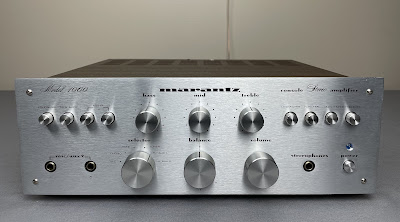
_before%20servicing.jpg)
_after%20servicing.jpg)
_before%20servicing.jpg)
_after%20servicing.jpg)
_before%20servicing.jpg)
_after%20servicing.jpg)
_bad%20soldering,%20one%20lead%20was%20not%20soldered.jpg)
_before%20servicing.jpg)
_after%20servicing.jpg)



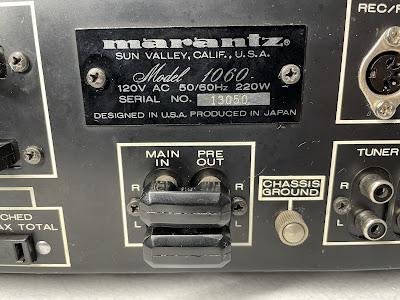

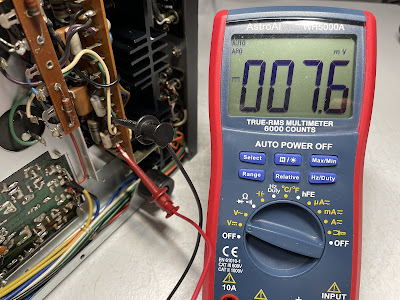






_before%20servicing.jpg)
_after%20servicing.jpg)
_before%20servicing.jpg)
_after%20servicing.jpg)
_before%20servicing.jpg)
_after%20servicing.jpg)
_before%20servicing.jpg)
_after%20servicing.jpg)
_before%20servicing.jpg)
_after%20servicing.jpg)
_before%20servicing.jpg)
_foil%20side_before%20servicing.jpg)
_after%20servicing.jpg)
_foil%20side_after%20servicing.jpg)
